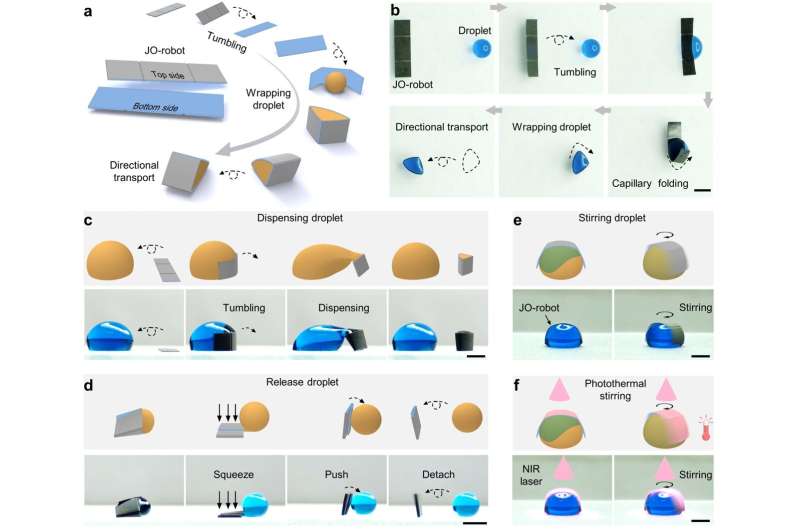This article has been reviewed according to Science X's editorial process and policies. Editors have highlighted the following attributes while ensuring the content's credibility:
fact-checked
peer-reviewed publication
proofread
Scientists achieve femtosecond laser fabrication of magnetic-responsive Janus origami robots

The versatile manipulation of droplets across different scales holds significant promise in various fields, particularly in precision chemistry and biomedical diagnostics. From a practical standpoint, effective droplet manipulation techniques necessitate multi-functional integration and applicability across various scales.
Magnetic excitation has gained widespread adoption in the field of droplet manipulation due to its advantages, such as remote controllability, biocompatibility, insensitivity to environmental factors like substrate charge, and excellent transparency. However, expanding the capabilities of magnetically responsive droplet manipulation and extending the diverse functionalities from microliter to nanoliter scales remain formidable challenges.
In response to this challenge, Professor Hu Yanlei and his research team from the Micro/Nano Engineering Laboratory at the University of Science and Technology of China (USTC) of the Chinese Academy of Sciences (CAS), in collaboration with other researchers, developed a magnetically actuated Janus origami robot using femtosecond laser nanofabrication techniques.
This robot enables effective integration of diverse droplet manipulation functionalities, including three-dimensional droplet transport, merging, splitting, precise dispensing, and on-demand release of daughter droplets, as well as stirring and remote heating.
In addition, this manipulation strategy exhibits remarkable stability and allows for the manipulation of droplets spanning volumes from approximately 3.2 nanoliters to about 51.14 microliters. The results of this research, titled "Magnetic Janus origami robot for cross-scale droplet omni-manipulation," have been published in Nature Communications.
The upper and lower surfaces of the magnetic responsive bilayer Janus origami robot exhibit distinct wetting properties. The upper surface of the robot is in a superhydrophobic state with low droplet adhesion, while the lower surface is hydrophobic with high droplet adhesion.
Simultaneously, two creases are designed on the upper surface of the robot to facilitate spontaneous envelopment of droplets under capillary forces upon contact. The overall profile, creases, and surface micro/nano-functional structures of the robot are fabricated and modified through femtosecond laser scanning.
Driven by a magnetic field, the robot actively approaches and encapsulates water droplets by rolling, enabling controlled droplet transportation. Furthermore, the magnetic responsive bilayer Janus origami robot can distribute daughter droplets from larger droplets through directed rolling and folding.
By controlling the magnetic field strength, the distributed daughter droplets can be extruded from the robot. Leveraging its specially designed superhydrophobic exterior, the robot gently pushes droplets for controlled release and separation. The robot can also rotate under the influence of the magnetic field, achieving controlled liquid mixing, and, in combination with its photothermal properties, enabling remote heating.
Magnetic-responsive Janus origami robots have been developed to enable versatile cross-scale droplet manipulation, offering features akin to commercial magnetic stirrers. Beyond rapid mixing of water, these robots exhibit the capability to effectively mix high-viscosity liquids such as glycerol through their heating and stirring functions, achieving temperatures exceeding 80°C.
Building upon their diverse droplet manipulation capabilities, the magnetic-responsive Janus origami robots seamlessly integrate various droplet-handling functionalities to achieve continuous droplet manipulation objectives. For instance, the robots autonomously approach water droplets through rolling motions, dispense specific volumes of daughter droplets, transport these dispensed daughter droplets to merge with other droplets, and finally facilitate rapid mixing of different-component droplets through stirring. This multifunctional droplet manipulation integration extends seamlessly to the nanoliter scale.
In a proof-of-concept demonstration, the robots, following surface modifications, successfully accomplished the extraction and purification of nucleic acids.
In summary, magnetic-responsive Janus origami robots enable cross-scale droplet manipulation, holding significant implications for precise reagent delivery, microdroplet patterning, and rapid microdroplet reactions in diverse fields such as fine chemical engineering, medical diagnostics, and microfluidic technologies.
More information: Shaojun Jiang et al, Magnetic Janus origami robot for cross-scale droplet omni-manipulation, Nature Communications (2023). DOI: 10.1038/s41467-023-41092-1
Journal information: Nature Communications
Provided by University of Science and Technology of China





















